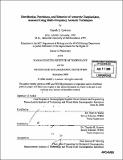| dc.contributor.advisor | Peter H. Wiebe and Timothy K. Stanton. | en_US |
| dc.contributor.author | Lawson, Gareth L | en_US |
| dc.contributor.other | Woods Hole Oceanographic Institution. | en_US |
| dc.coverage.spatial | t------ | en_US |
| dc.date.accessioned | 2007-10-19T20:32:59Z | |
| dc.date.available | 2007-10-19T20:32:59Z | |
| dc.date.copyright | 2006 | en_US |
| dc.date.issued | 2006 | en_US |
| dc.identifier.uri | http://hdl.handle.net/1721.1/39220 | |
| dc.description | Thesis (Ph. D.)--Joint Program in Oceanography/Applied Ocean Science and Engineering (Massachusetts Institute of Technology, Dept. of Biology; and the Woods Hole Oceanographic Institution), 2006. | en_US |
| dc.description | Includes bibliographical references (p. 297-311). | en_US |
| dc.description.abstract | The physical and biological forces that drive zooplankton distribution and patchiness in an antarctic continental shelf region were examined, with particular emphasis on the Antarctic krill, Euphausia superba. This was accomplished by the application of acoustic, video, and environmental sensors during surveys of the region in and around Marguerite Bay, west of the Antarctic Peninsula, in the falls and winters of 2001 and 2002. An important component of the research involved the development and verification of methods for extracting estimates of ecologically-meaningful quantities from measurements of scattered sound. The distribution of acoustic volume backscattering at the single frequency of 120 kHz was first examined as an index of the overall biomass of zooplankton. Distinct spatial and seasonal patterns were observed that coincided with advective features. Improved parameterization was then achieved for a theoretical model of Antarctic krill target strength, the quantity necessary in scaling measurements of scattered sound to estimates of abundance, through direct measurement of all necessary model parameters for krill sampled in the study region and survey period. | en_US |
| dc.description.abstract | (cont.) Methods were developed for identifying and delineating krill aggregations, allowing the distribution of krill to be distinguished from that of the overall zooplankton community. Additional methods were developed and verified for estimating the length, abundance, and biomass of krill in each acoustically-identified aggregation. These methods were applied to multi-frequency acoustic survey data, demonstrating strong seasonal, inter-annual, and spatial variability in the distribution of krill biomass. Highest biomass was consistently associated with regions close to land where temperatures at depth were cool. Finally, the morphology, internal structure, and vertical position of individual krill aggregations were examined. The observed patterns of variability in aggregation characteristics between day and night, regions of high versus low food availability, and in the presence or absence of predators, together reinforced the conclusion that aggregation and diel vertical migration represent strategies to avoid visual predators, while also allowing the krill access to shallowly-distributed food resources. The various findings of this work have important implications to the fields of zooplankton acoustics and Antarctic krill ecology, especially in relation to the interactions of the krill with its predators. | en_US |
| dc.description.statementofresponsibility | by Gareth L. Lawson. | en_US |
| dc.format.extent | 311 p. | en_US |
| dc.language.iso | eng | en_US |
| dc.publisher | Massachusetts Institute of Technology | en_US |
| dc.rights | M.I.T. theses are protected by copyright. They may be viewed from this source for any purpose, but reproduction or distribution in any format is prohibited without written permission. See provided URL for inquiries about permission. | en_US |
| dc.rights.uri | http://dspace.mit.edu/handle/1721.1/7582 | |
| dc.subject | /Woods Hole Oceanographic Institution. Joint Program in Oceanography/Applied Ocean Science and Engineering. | en_US |
| dc.subject | Biology. | en_US |
| dc.subject | Woods Hole Oceanographic Institution. | en_US |
| dc.subject.lcsh | Underwater acoustics | en_US |
| dc.subject.lcsh | Marine zooplankton Geographical distribution | en_US |
| dc.title | Distribution, patchiness, and behavior of Antarctic zooplankton, assessed using multi-frequency acoustic techniques | en_US |
| dc.type | Thesis | en_US |
| dc.description.degree | Ph.D. | en_US |
| dc.contributor.department | Joint Program in Oceanography/Applied Ocean Science and Engineering | en_US |
| dc.contributor.department | Woods Hole Oceanographic Institution | en_US |
| dc.contributor.department | Massachusetts Institute of Technology. Department of Biology | |
| dc.identifier.oclc | 85869480 | en_US |
